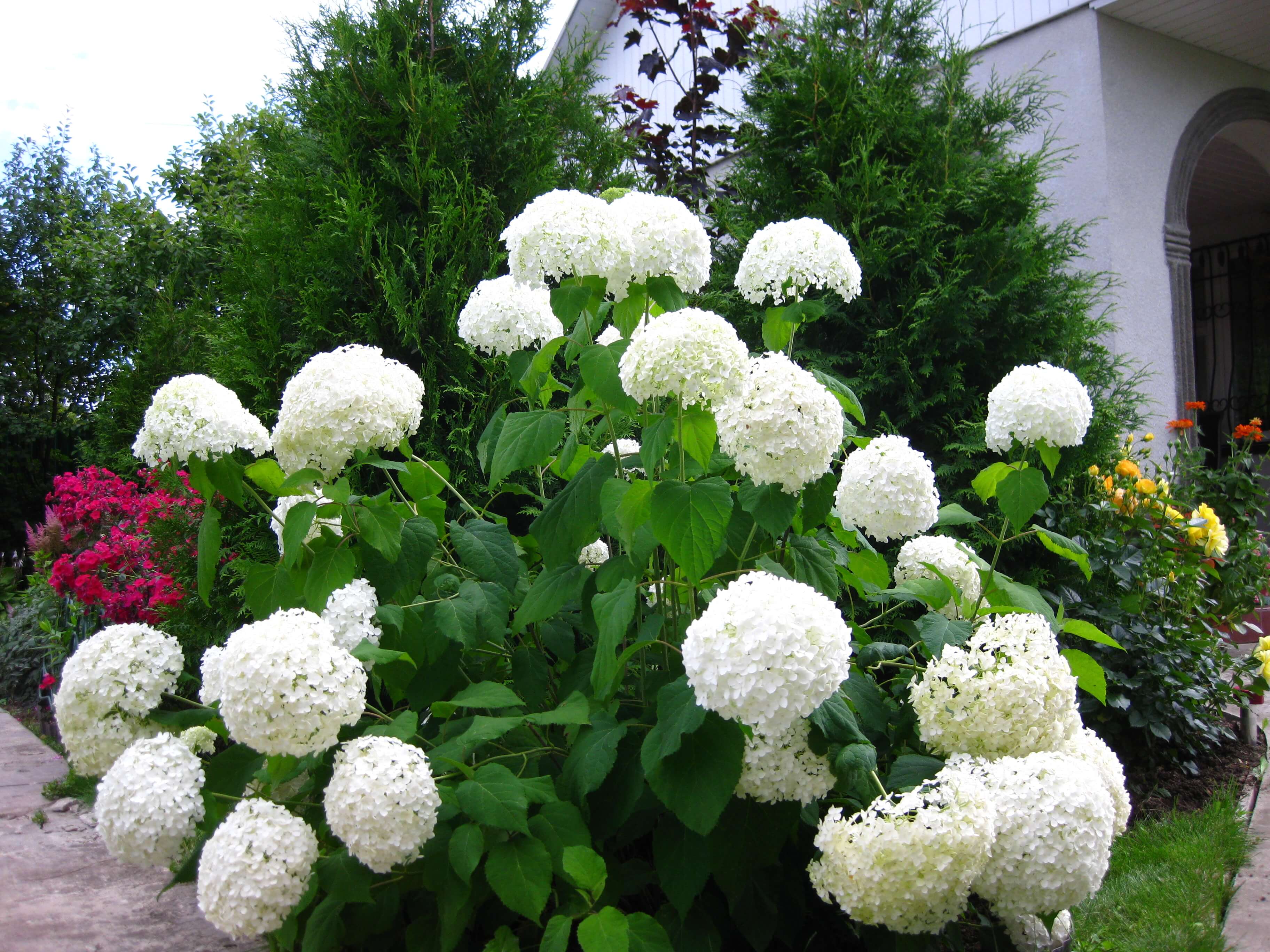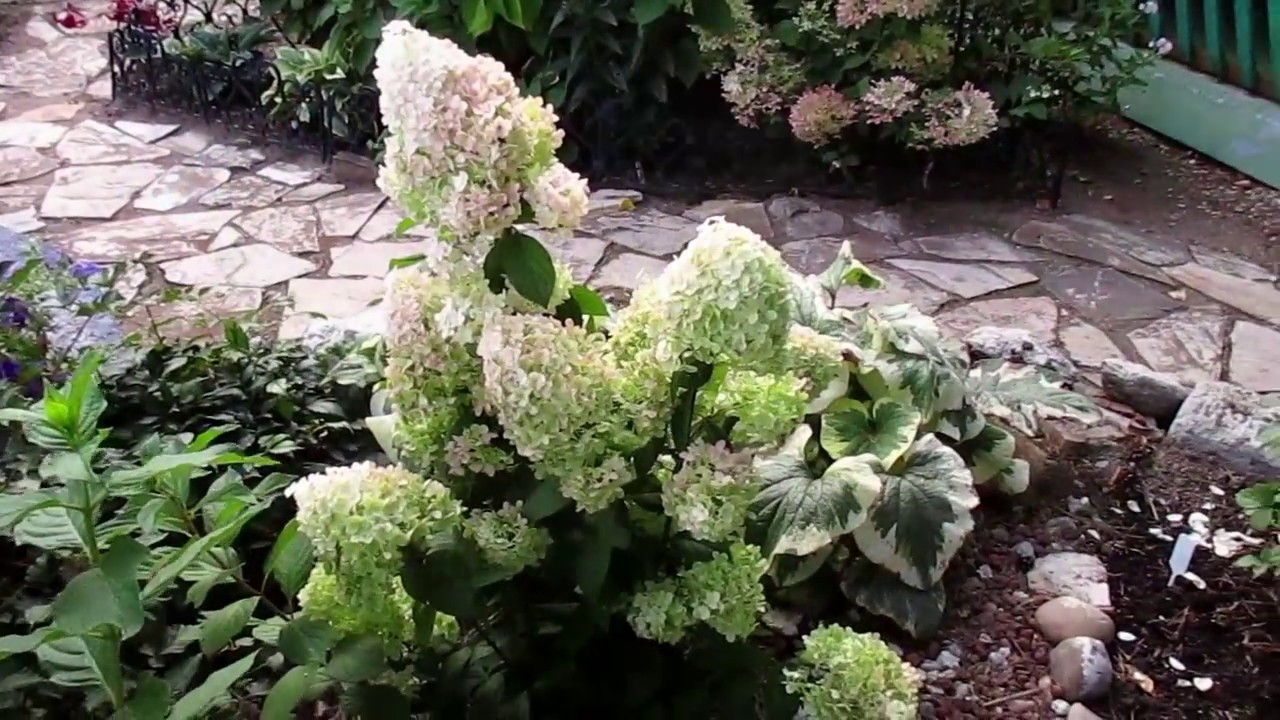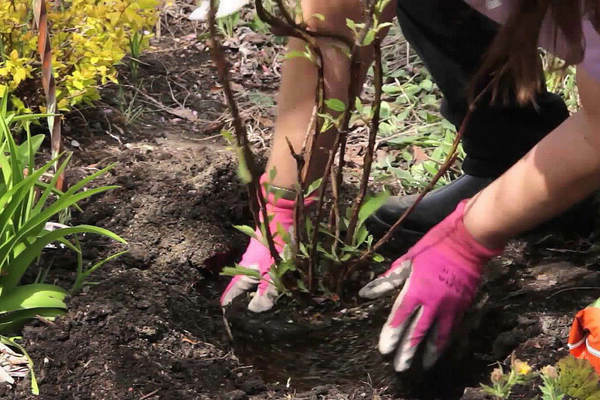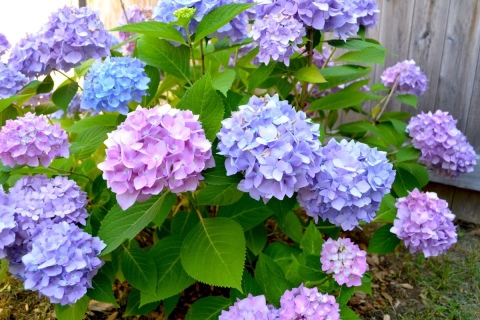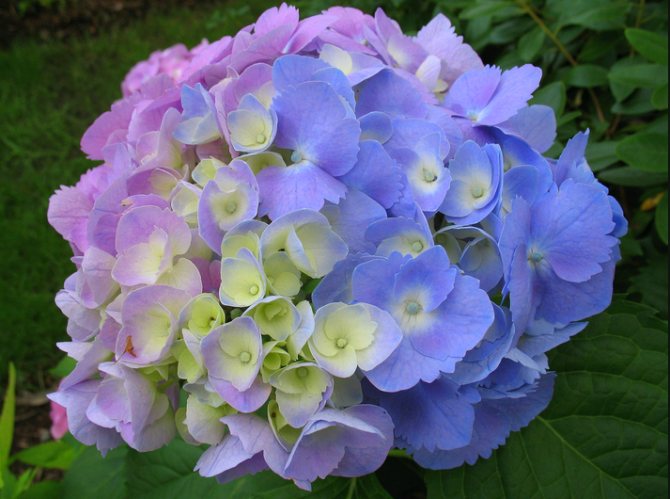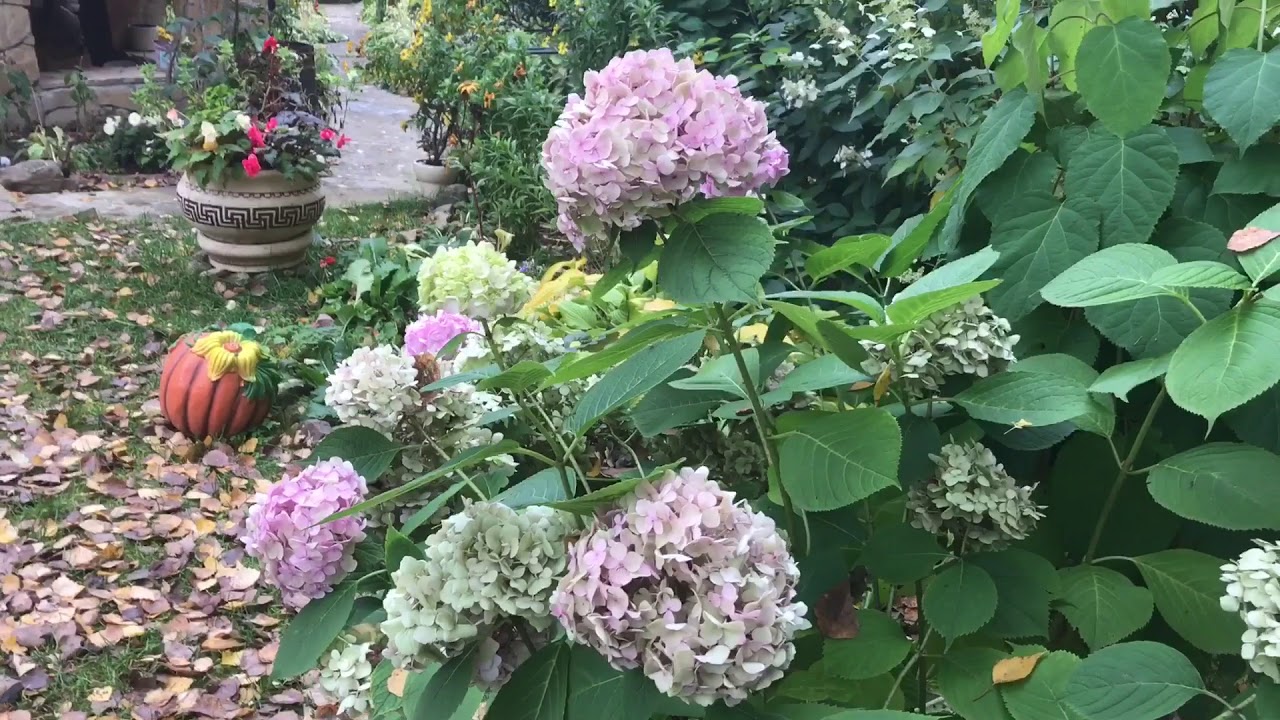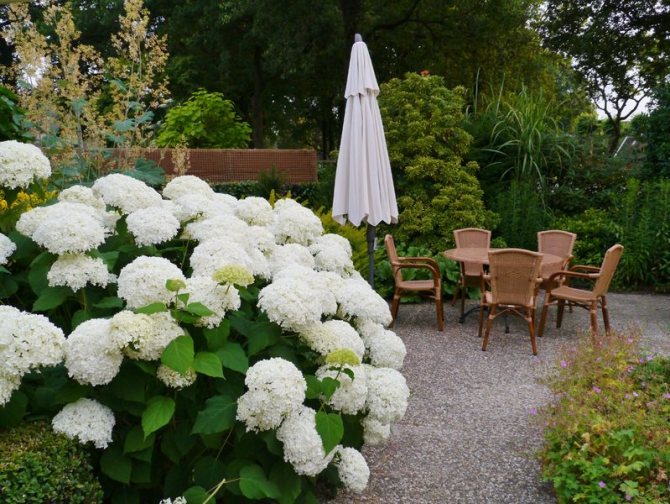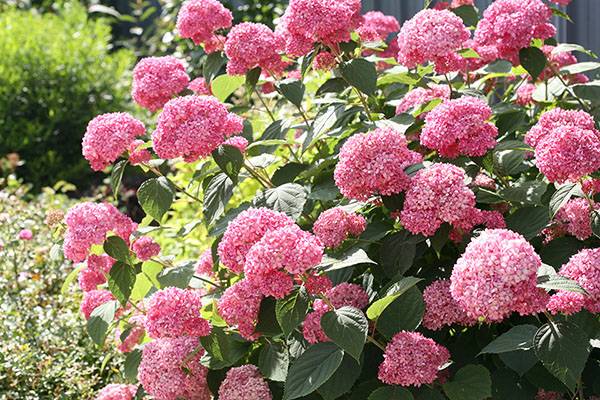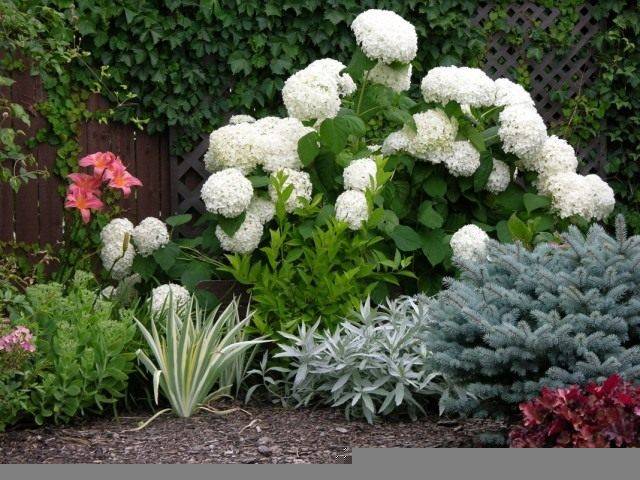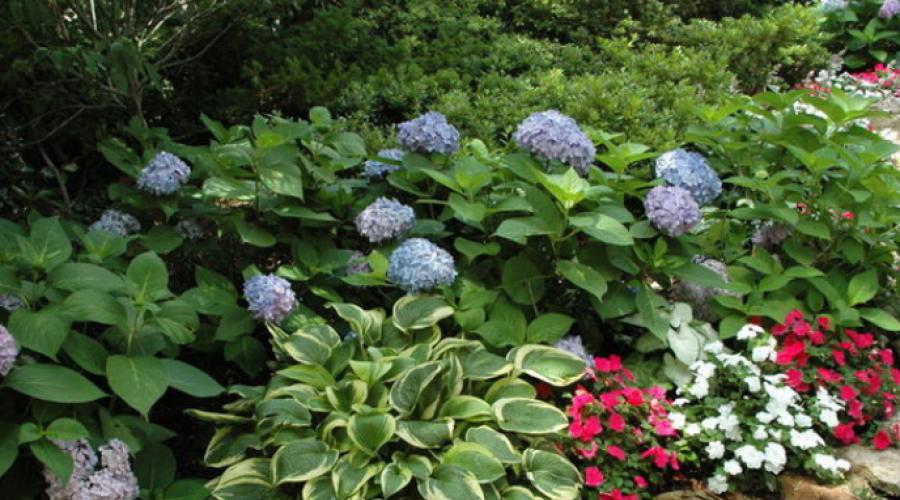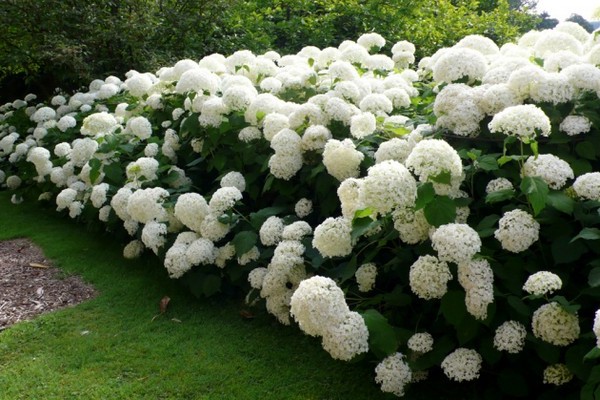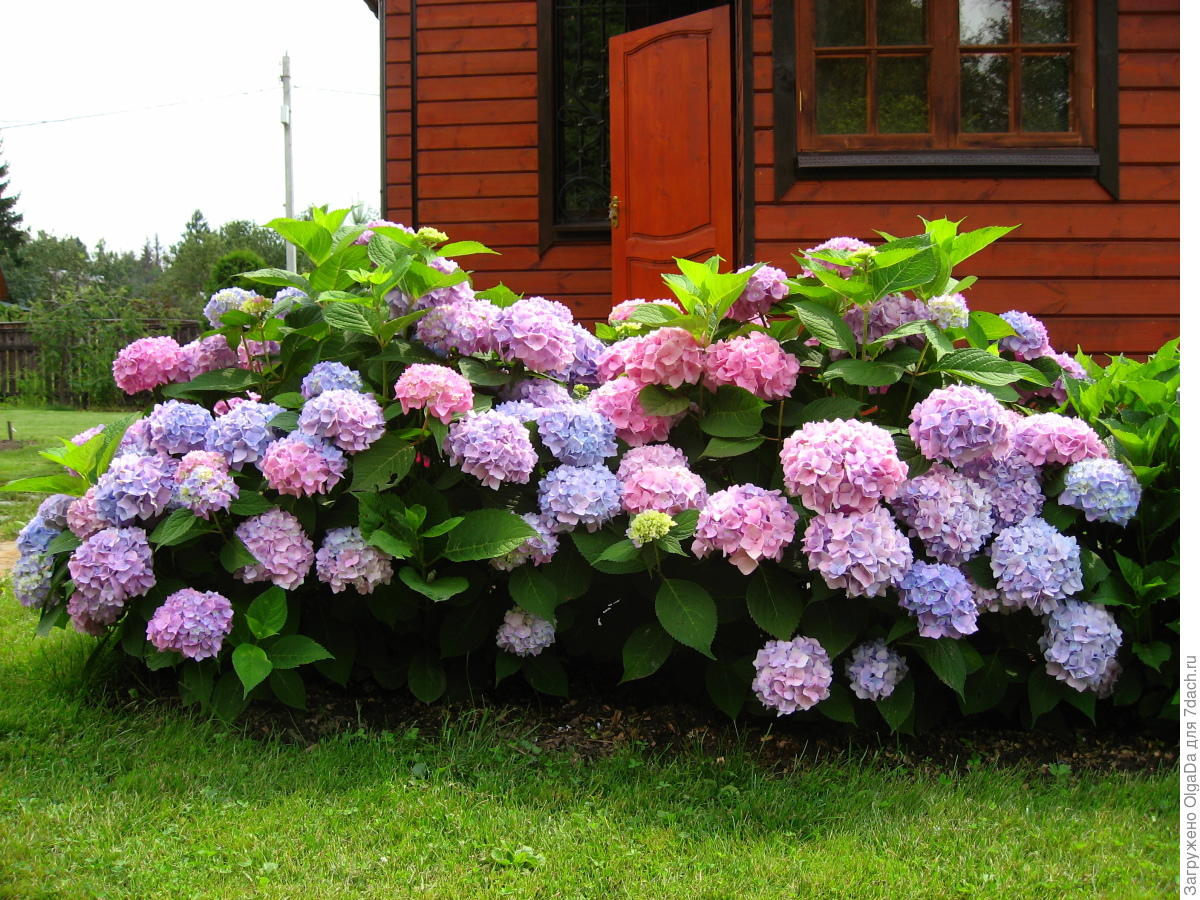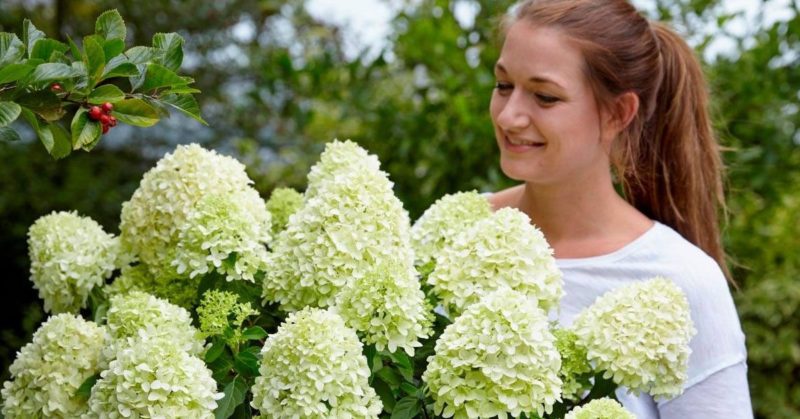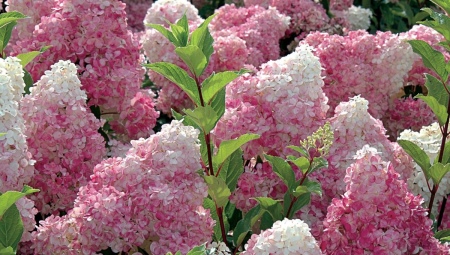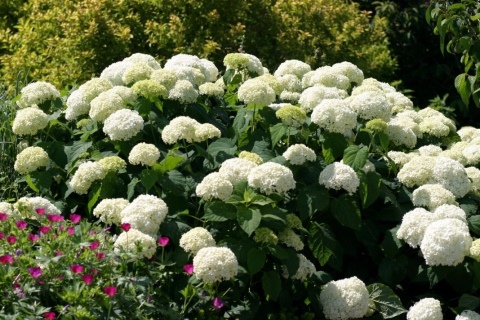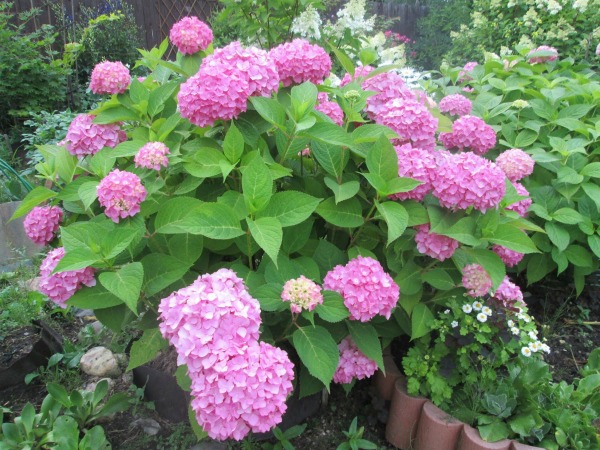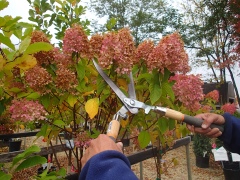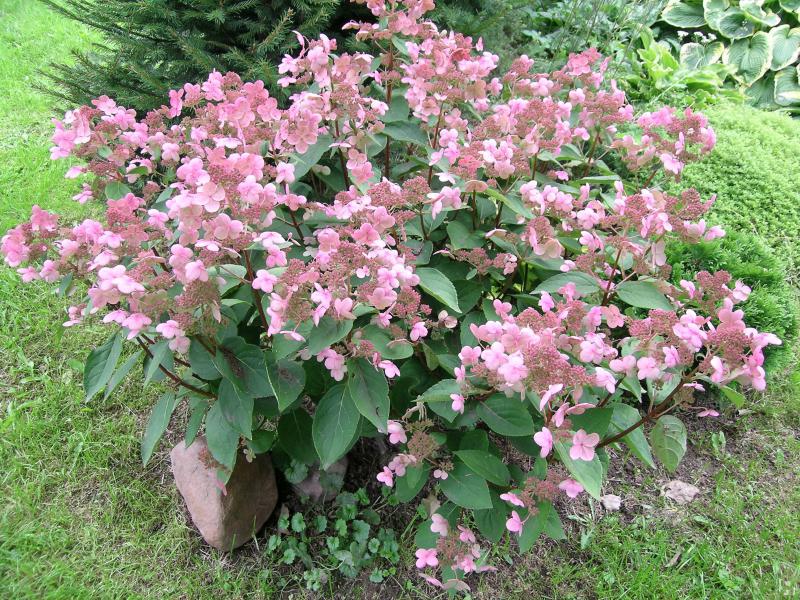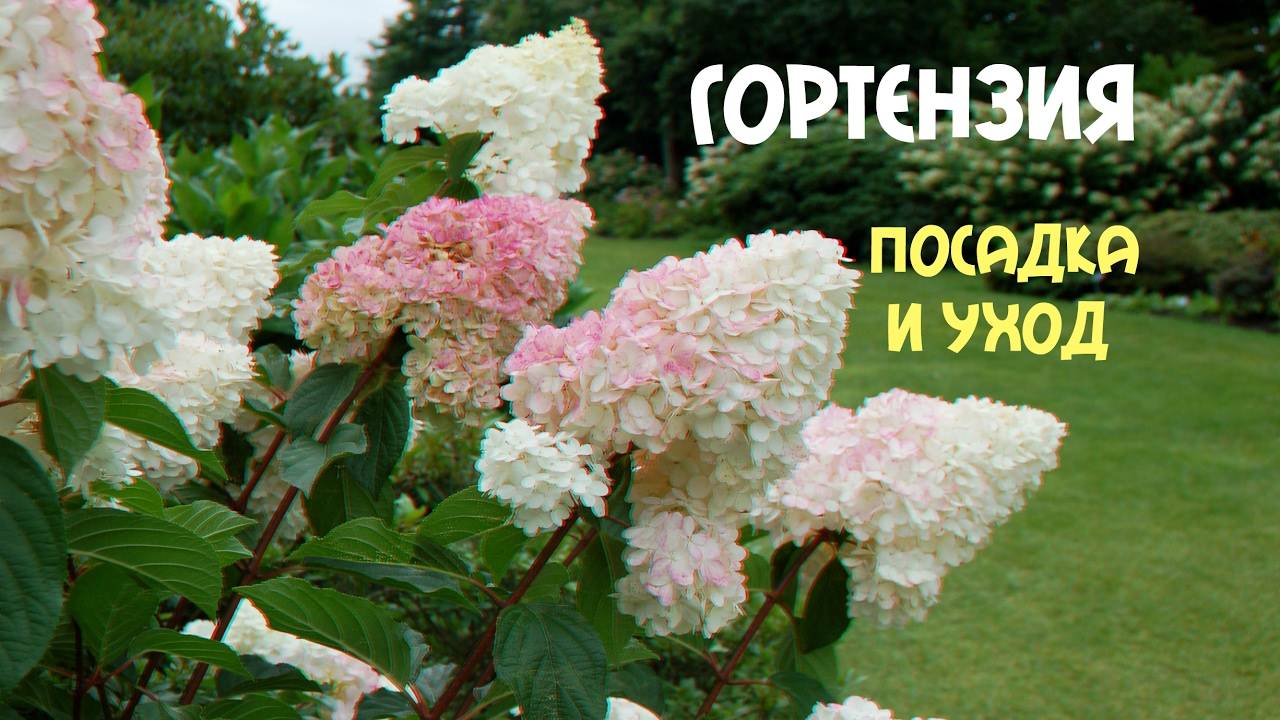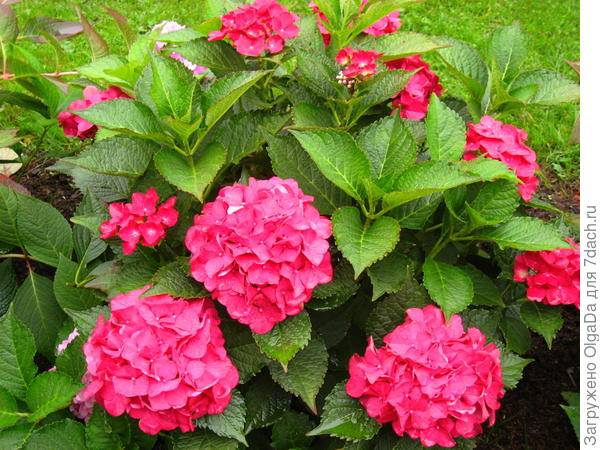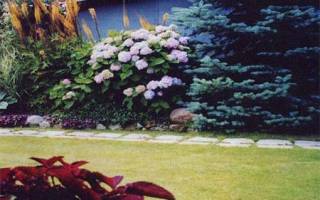The hydrangea bush is afflicted with disease
Hydrangeas that are grown in waterlogged soils (near water bodies) or are too thickened are often prone to fungal diseases. Hydrangeas can be affected by powdery mildew or leaf spot, suffer from gray rot.
As a result of the defeat of a fungal disease, the plant weakens, its growth is inhibited and, as a result, flowering weakens
That is why it is so important to provide proper conditions for growing hydrangeas, as well as to carry out early and correct diagnosis of fungal diseases, and to use appropriate fungicides for treatment.
Prophylactically, to prevent diseases, plants can be sprayed with growth and flowering biostimulants.
Features of flowering hydrangea of different types

Sometimes gardeners abuse hydrangea pruning without specifying whether this particular variety can be pruned. Some species form inflorescences on young shoots, respectively, autumn pruning will only benefit them. And many types of hydrangeas are able to form inflorescences only on the shoots of last year, cutting off such bushes in the fall you will never wait for flowering.
Panicle hydrangea varieties bloom just on young shoots, so such popular varieties as Large-flowered, Vanilla Strawberry, Limelight can be safely cut off without fear of harming the flowering. In cold regions, it is better to plant such a plant in a sunny place, and in the south, where the climate is hotter, the place for the hydrangea must be chosen so that the plant is in partial shade for part of the day. Like any plant, hydrangea needs sunlight, but under the scorching midday rays, it will not feel very good.
In order for panicle hydrangeas to bloom profusely, they must be watered in a timely manner, pruning should be carried out in the spring, before sap flow begins. Feed your hydrangea with organic matter, it responds especially well to compost. And also do not forget to remove faded inflorescences.
Smooth-leaved hydrangea varieties, such as Anabel, Bella Anna, Invisible Spirit, as well as paniculate ones, bloom on the shoots of the current year. This is one of the most unpretentious types of hydrangea, which got its name for its large, smooth leaves. Care for smooth-leaved varieties should be the same as for paniculate varieties, spring pruning should be carried out annually, and the plant will annually delight you with flowering.
We will pay a little more attention to large-leaved hydrangea varieties, since in most cases it is they who have problems with flowering. Flowers are formed on the shoots of last year, if you recklessly cut the hydrangea, or poorly covered it for the winter and the shoots are frozen, then, of course, the plant will not be able to bloom.
In the spring, if necessary, it is necessary to carry out sanitary pruning, removing damaged branches. If the formation of a bush is required, then this should be done in August, since flower buds begin to form in the fall and you will not damage them by pruning in August.
1 Unsuccessful seedling planting site
Hydrangea feels uncomfortable in open places, being under the scorching rays of the sun all day. Delicate leaves of many varieties sag lifelessly and burn in the heat.

In a sunny place, the plant will be saved by an underestimated planting. The trunk circle of the bush should be 10 cm below ground level. It must be mulched with coarse peat or sawdust to the surface of the earth. In such conditions, the plant can develop and bloom normally.
In hot and sunny regions, it is better to grow panicle hydrangea.With regular moisture, it will withstand direct sunlight all day long without compromising flowering.
In deep shade, under the crowns of large trees, hydrangea is unlikely to please with its lush color. A perennial grows poorly with strong shading, regardless of which variety is planted. If flowers appear, they will be sparse and underdeveloped.

All plant varieties prefer places where the sun's rays fall only before lunch. In such conditions, hydrangea blooms especially brightly, magnificently and for a long time.
If the place for the shrub was chosen unsuccessfully and the situation cannot be corrected in any way, you need to transplant it. This should be done only as a last resort, since the plant does not tolerate the transplant well. The most suitable time for transplanting is autumn. At this time, the perennial is at rest.
Having picked up a suitable site, you need to dig a hole to a depth of 50 cm. The extracted soil is mixed with 2 buckets of humus and 80 g of mineral fertilizer is added. Hydrangea loves acidic soil and grows quickly in it. Therefore, the soil for it must be acidified with a solution of sulfuric acid (1 tsp per 10 liters of water).
The plant must be transplanted very carefully, along with a lump of earth. If the root system is damaged during transplantation, the plant will not bloom for a long time.
The reasons for his absence
The reasons why street hydrangea does not form peduncles and buds can be different:
- the composition of the soil is not suitable for the plant;
- the root system is weakened and poorly developed;
- incorrect irrigation regime;
- lighting problems;
- excess, or, conversely, lack of fertilizers;
- freezing of shoots;
- wrong landing site;
- diseases and garden pests;
- incorrect pruning.
When buying planting material, it is advisable to contact specialized nurseries. When choosing a garden hydrangea bush in the market and in a little-known store, many prefer specimens with abundant flowering. However, in practice, this does not always become an indicator of good plant health. In most cases, growth stimulants are used to give the seedling a presentation. The fact is that such amplifiers create an increased load on the vegetative features of hydrangeas, subsequently such bushes do not form flowers for a long time, and sometimes it happens that the owners do not see flowering at all. It is better to immediately refuse to purchase such a seedling, and make a choice in favor of a non-flowering specimen.
When you purchase planting material, make sure that the plant is not greenhouse - such material takes root very poorly in the open field.
Errors in feeding often cause the lack of inflorescences in a garden hydrangea. The introduction of nitrogen-containing fertilizers into the soil stimulates the active growth of green mass, potash and phosphorus fertilizers have a beneficial effect on flowering, its splendor and duration. Inexperienced growers believe that street hydrangeas do not need nitrogen for the appearance of flowers - and this is a big mistake. Nitrogen preparations contribute to the formation of shoots, on which buds are laid by the fall, ejecting flower stalks in the subsequent growing season, but such fertilizers need to be applied only in spring. In summer, emphasis should be placed on preparations containing potassium and phosphorus - they will maintain the duration of flowering.


Hydrangea may not produce peduncles due to illiterate pruning - this is one of the most common reasons for non-flowering. If you cut off all the shoots in the fall, the plant will never bloom the next spring. The fact is that the buds, which should bloom, begin to form in the fall.
It is important that they overwinter and be able to wake up with the onset of warmth, therefore, autumn pruning should be limited to the removal of dry branches, weakened and overgrown shoots, it is also necessary to cut off the bushes growing inward - they worsen the decorative state of the plant
Keep in mind that buds form at the tops of the shoots, so there is no need to shorten healthy hydrangea branches.
A factor of weak flowering or its complete absence may be a lack of lighting. This is quite common in areas where natural sunlight is available to a limited extent.To fix the problem, you need to set up additional lighting or move the plant to where there is enough sunlight.

Hydrangea often does not form buds due to freezing of the buds in winter. Most of the unpretentious varieties of hydrangea easily tolerate the cold, but in recent years the winters have little snow, so the hydrangea needs to be covered for the winter, and the sooner you do this, the better. It is optimal to carry out all the necessary work in the second decade of September. In calm dry weather, the flexible shoots of the shrub are carefully bent to the substrate and fixed with garden clips. Woody shoots often break with strong pinning, so large stones, bricks or a layer of spruce branches can be applied under them. Then the bush is covered with agrofiber or other non-woven material. Remember: high-quality ventilation must be maintained under the shelter, so plastic wrap cannot be used. From above, the bush is sprinkled with peat or soil with a layer of 8-15 cm and covered with needles.
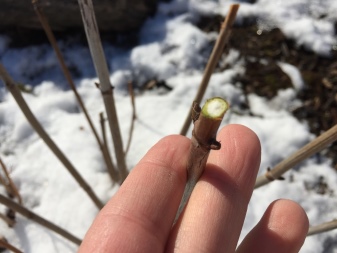
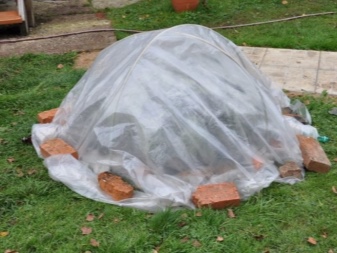
7 Diseases and pests
The reason why hydrangea does not bloom in the garden may be alkalization of the soil. Even if the flower is planted in the most suitable soil, the soil will become more alkaline over time. Due to the low acidity of the soil, the plant disrupts the absorption of iron and develops iron chlorosis (lack of iron).

A sign of chlorosis is the prominent green veins on the lightened and yellowed background of the leaf plate. The leaves decrease in size, curl and fall off. The shape of buds and flowers changes. They dry out and crumble.
You can notice a decrease in soil acidity by changing the color of the inflorescence. If blue or blue flowers begin to acquire a lilac color, the acidity of the soil decreases. Pink hydrangea will bloom on slightly acidic and neutral soil.
Hydrangea growing in soil rich in lime often falls ill with chlorosis. Only the tree hydrangea is able to tolerate lime in the soil.
To cure the plant, you need to prepare a solution of potassium nitrate. It is prepared from 40 g of potassium nitrate and 10 liters of water. The composition is watered with hydrangea for 3 days in a row, and on the fourth day, iron sulfate is added to the soil.
You can quickly and easily solve the chlorosis problem with rust. It is scraped off large metal objects and mixed with root soil. Rusty nails or tin lids can be buried near the roots.
To prevent the development of chlorosis, you need to regularly water the shrub with special fertilizers for hydrangeas.
In spring, chlorosis can develop due to sharp fluctuations in temperature during the day and night. The metabolism in the plant is disturbed if the roots are in cold soil, and the ground part is warmed up by the sun's rays. As the soil warms up, the plant recovers.
In addition to chlorosis, aphids, spider mites and powdery mildew can interfere with flowering. They interfere with the development of plants by slowing down or stopping the flowering process. For pest control, modern means on a biological or chemical basis are used.

What are the types of blooming hydrangea
Annabelle is the most common type of hydrangea, which has large fluffy flowers and grows up to 2 meters.
Panicle hydrangea tolerates cold well and grows up to 5 meters. Flowers can be red, cream and yellowish.
Indoor hydrangea is considered one of the most capricious and at the same time the most beautiful flowers. It is capable of changing color, depending on the composition of the soil.

If you want to decorate an arch in your garden, choose a climbing hydrangea. Keep in mind that this species does not tolerate cold well.
Reasons why hydrangea does not bloom
If the hydrangea does not give flowers, but only goes into the foliage, it is necessary to determine the reasons why. Although this shrub is unpretentious, it must be properly pruned in the spring.
Particular attention should be paid to watering, lighting and fertilization.If you do not feed the soil, then there will be only foliage, not lush flowers.
It is important that the plant develops a good root system, otherwise it will be weak and will not bloom
Indoor hydrangea
One of the most common reasons why a hydrangea does not bloom, but gives only foliage, is that sellers may have used flowering stimulants, after which the plant may not bloom for several more years. If your hydrangea does not bloom, but gives only foliage, think about whether it froze over in winter. You may need to cover the bush if it is very cold in your area.
After you figured out the reasons why the hydrangea bush does not bloom, proceed to proper care for it. Flowering can be restored anyway, so don't worry.
How to care for hydrangea
It is very important to feed the plant in a timely manner. This should be done on average about 4 times a year, in the spring and summer.
In early spring, start with organic fertilizers to stimulate hydrangea growth and flowering. During the period of active growth of buds, one more top dressing should be carried out, adding, in addition to organic fertilizers, urea and potassium salts. In the summer, apply mineral fertilizers, and then special mixtures for hydrangeas.

When caring for hydrangea, you need to monitor the humidity of the air. If it's too dry, spray the leaves.
Pay special attention to watering as the plant loves moist soil. Hydrangea grows best on clay soils and poorly on sandy
If the PH of the earth is acidic, then add sawdust and needles to the soil before planting the hydrangea.
Now you know what to do if the hydrangea does not bloom, but gives only foliage. With your own hands, you can grow lush flowering bushes and transform your own site.
Hydrangea is a popular decorative flower among gardeners. It belongs to the category of capricious cultures. Errors in growing technology lead to a lack of flowers. There are several reasons why the plant does not bloom
It is important to diagnose them correctly, and then eliminate negative factors.
Growing conditions for indoor hydrangeas
The key to maintaining hydrangeas and blooming for a long time is the right lighting and temperatures. They do not adapt well to a new place and prefer a stable environment.
Lighting and placement
Even in rooms, hydrangea can grow not only in a brightly lit place, but also in partial shade. Of course, hydrangeas cannot stand strong shading, but diffused light is quite comfortable for them.
Most hydrangeas that do not form into dwarfs do not fit well on windowsills over time. It is quite possible to place them both on furniture and outdoor not far from the window. Bushes cannot stand direct sunlight, they very quickly lead to a loss of decorativeness of inflorescences and foliage.
During flowering, it is better to make sure that the lighting remains soft and unchanged, and the hydrangeas do not change their orientation in relation to the window: turning, moving can be perceived by the plant as stress and cause accelerated fading.
Lighting during the dormant period for hydrangeas is important, but not in the sense that it is for ordinary indoor plants: hydrangeas should be placed in a dark place or put on caps on bushes, protecting them from light. True, only after shedding the leaves
"Naked" hydrangeas are returned to light only after the beginning of the swelling of the buds.
Indoor hydrangeas are plants that overwhelm their neighbors. They are so massive and attractive that few houseplants are capable of not losing their charm next to them.
But a negative influence is not uncommon: hydrangeas next to crops with glossy leathery leaves, impeccable shapes can seem more sloppy and lose some of their aristocratic charm. Therefore, it is better to expose them as living bouquets of soloists, beautiful single decorations. Except, of course, for the company of other hydrangas.
Temperature control and ventilation
Moving to closed living quarters, hydrangeas become less resistant to temperatures. They need mild conditions and stable cool temperatures, reminiscent of a cozy garden partial shade under the trees.
Hydrangeas look, develop and bloom best of all, which from March to October stay in moderate room temperatures no higher than 20 degrees. A range of 18 to 20 degrees is fine for them. The higher the temperature, the faster the hydrangeas will bloom and the less they will reveal the beauty of their leaves.
The dormant period for hydrangeas should be cool. The maximum permissible temperature for wintering a plant is plus 10 degrees. Optimal - about 5 degrees Celsius. Only after wintering in the coolness can hydrangeas bloom, and the quality of their flowering directly depends on comfortable and stable temperatures.
You can find a suitable place for indoor hydrangeas during wintering both in cellars, basements, cold greenhouses, and between frames or in a cold foyer.
Hydrangeas, as true garden plants, will not refuse to move under the open sky for the summer. It is not necessary to put them on balconies or in the garden, but it is highly desirable.
If you decide to leave the beauties in the room to admire their inflorescences, then they should not suffer from a lack of fresh air. Airing should be neat, and if the doors are constantly ajar, it is worth taking measures to protect the bushes from drafts.
If hydrangeas are planned to be transferred to the soil or there is a large collection, they can also winter in the soil - dug in, under an air-dry shelter, or together with garden tubs.
Hydrangea large-leaved 'Blushing Bride'. Mark bolin
Types and varieties of blooming hydrangea
In the middle latitudes, close to the Russian ones, the same subspecies are regularly grown. They have excellent resistance to existing climatic conditions, and also have a high immunity to the appearance of diseases, especially those caused by fungal infections. Popular types of hydrangea are:
- Paniculata, or paniculata hydrangea (Paniculata). The bush has large panicle-shaped inflorescences that reach a diameter of 30 cm. It grows up to 5 meters, at home it does not exceed 3 meters.
- Oak-leaved. Sprawling shrub with abundant flowering and large flowers. It got its name from the shape of the plates, which resemble oak leaves. Oak-leaved hydrangea is a frost-resistant plant that can withstand temperatures as low as -30 ℃.
- Serrated. A short flower, not exceeding 2 m in height. The subspecies was named because of the shape of the leaf plates, in which the jagged edges reach a length of 8-10 cm. It has a bright blue color of flowers.

Most often, hydrangeas are grown in the garden outdoors.
- Petiolate. It grows in the form of a creeping vine, the shoots of which can reach 20 m in length. Belongs to the deciduous group of ornamental plants. Has a palette of colors and shapes of buds.
- Garden large-leaved. The shrub grows up to 1.5 meters and has oval-shaped elongated leaves. Large flowers are collected in inflorescences in the shape of a ball and exude a strong spicy aroma. Most often, the buds have a pink tint, but there are varieties with a different color of the petals.
- Tree-like. It is characterized by abundant flowering and large snow-white inflorescences. The height of the bush is 1.5-2 meters. The leaves are slightly elongated, oval in shape with a slight taper at the ends.
Among the most beautiful varieties are:
- Anabel is a treelike hydrangea with large and lush white inflorescences, which are almost 30 cm in diameter;
- Bobo - refers to a paniculate species, a low shrub 70 cm high with huge cone-shaped creamy white inflorescences;
- Vanilla Freyz is a paniculate variety with cone-shaped inflorescences, which are painted in bright pink at the base (closer to the peduncles), and have a white color closer to the edges;
- Limelight is a panicle hydrangea of the subspecies, characterized by large spherical inflorescences of a pale green color, with time acquiring a pinkish tint;
- Phantom or Phantom - a paniculata variety has cone-shaped apricot-peach flowers that overshadow glossy bright green plates.
- Grandiflora is a bush with wide triangular inflorescences with a creamy snow-white pinkish tint, the diameter of which is 40 cm.
Why does not the bush bloom
How to make it bloom:
Nutrition is the main stimulator of bud formation. Regardless of the variety / variety, starting from the third year, top dressing is done
It is important to understand the types of mineral fertilizers, to know what they affect
- Pick up food
Nitrogen fertilizers stimulate crown development. They are introduced during the period of active sap flow (April-May). Phosphorus and potassium give strength for the production of buds, affect the abundance of flowering, such feeding is carried out 2 times in the summer.
In the fall, to prepare for winter, strengthen the plant and lay flower buds, feed with phosphorus fertilizers is done.
- Know the reason
Hydrangea has more than 800 varieties, which are divided into subspecies. Each has its own care features. Consider 3 popular types and the reasons for the lack of colors on them:
Paniculata
This species has a long growing season, the first flowering occurs at 5-6 years of age, so it is important to know what year it blooms.
The reason for not blooming is often the composition of the soil. All paniculata love loam and moderate acidity.
On sandstone, heavy clay and depleted soil, panicle buds will not appear.
For lush flowering, you need to test the planting site, provide a slight acidity and make additional fertilizing
Large-leaved
The lack of buds is often due to freezing
Transfer this species to -18 ° C.
In cold regions, shelter with lutrasil or spruce branches is required.
Shield buds are formed on the shoots of the last year. This is an important factor to consider when cutting. If pruning is carried out on a stump or old wood, it will bloom in the second or third year.
Given the moisture-loving nature of these plants, watering is carried out abundant and frequent: once a week, 2-3 buckets
Tree-like
The longest-flowering species with wide-pyramidal thyroid panicles. Bud formation begins in the fifth year.
They have a high need for moisture, without watering in dry seasons, they can stop developing and do not form buds. Requires at least 5 abundant waterings per season.
Pruning does not affect bud formation. Inflorescences appear on seasonal shoots, so you can cut anytime, and how you want
With rejuvenating pruning on a stump, the decorativeness of the plant is restored in the second year, flowering occurs in the second or third.
Top dressing hydrangeas for good flowering
For the flowering of garden plants, top dressing is necessary. Hydrangea is no exception and needs special care - the abundance of flowers requires a full set of trace elements, and if the hydrangea does not bloom, then the reason may be precisely the lack of feeding.
Ready dressing
One of the best in composition is considered to be a complex feeding Pokon (Pokon).
For paniculate varieties - Agrecol (Agrecol). This preparation contains nitrogen, potassium oxide, aluminum.
The preparation Biopon (biopon) is rich in microelements - it contains nitrogen, phosphorus, potassium, magnesium. Serves for the formation of large buds and increases the plant's resistance to cold and disease.
Organic
You can improve the composition of the soil with the following additives:
red peat;
humus;
pine needles (better fallen);
slurry (preferably from chicken droppings);
sulfur (a teaspoon per 1 bush).
Hydrangeas are contraindicated in ash, chalk, lime. The introduction of these substances into the soil will slow down the development of the plant and exclude flowering, although the green mass will grow.
Chemicals
Urea - applied in the early spring (first feeding);
Potassium sulfate - applied from spring to late summer, during the flowering period - required;
Superphosphate - used, like potash fertilizers, during the budding period.
The lack of a particular substance is determined by the composition of the soil and the external state of the plant, in accordance with this, it is fed 1-2 times a month. They stop applying fertilizers from the moment of autumn pruning.
The ability to influence color is a rare gift from nature to man
The beauty of the spherical inflorescences of the hydrangea is provided by sterile four-petal flowers bordering nondescript small fertile ones. From the latter, a seed capsule is formed, they are honey plants, but they are admired, similar to moths, sterile flowers.
At the very beginning of flowering, regardless of the variety, they are all light green in color. Only over time it becomes obvious what color the panicles will be.
A palette of blooming hydrangeas: from chaste white and pale beige through all shades of pink to delicate tones of lilac, blue and blue. It's hard to believe, but the color of the inflorescences is determined by the acidity and content of chemical elements in the soil:
- the presence of Al or Fe in the form of alum guarantees all shades of blue;
- on slightly alkaline soils, sterile flowers will have a pink (natural) color;
- The change in color is also facilitated by the introduction of peat.
ATTENTION: On sale there are harmless chemical compositions that can change the color of the inflorescences, with a greater or lesser intensity according to the amount of the substance introduced.
This treatment is carried out during the beginning of the growing season. Regular use of additives gives the uniqueness of the color of the panicles, irregular - the manifestation of bi-color.
Special hybrids of hydrangeas have been bred that can change color and very easily "recolor" in the desired color - "NikkoBlue", "Blaumeise", etc. Snow-white varieties are the most difficult to change color; at best, their inflorescences can acquire a slightly pink tint. By influencing color samples, you can get complex shades of red and blue - lilac, violet.
People have discovered this feature of influencing the color of hydrangea inflorescences by experience for a long time: they buried rusty objects on the bush or watered the plant with rusty water.

